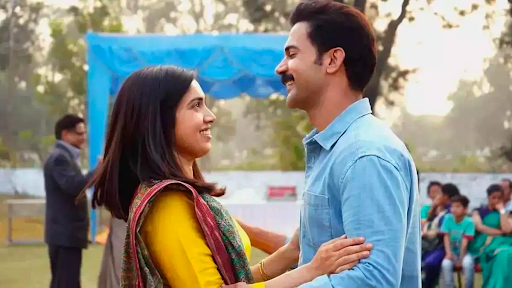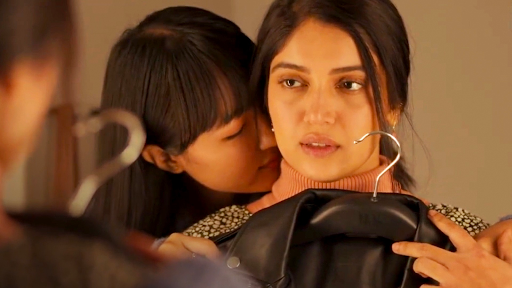Padma Danturty (she/her) It’s a fact that Indian LGBTQ representation, especially Indian lesbian representation, is extremely limited in the media. Whether it’s American television or Bollywood movies, I find it challenging to think of any examples of queer Indian women who we can turn towards for representation and inclusivity. Personally, it’s always felt like I had to choose between these two important identities when picking a movie to watch. I could always find an excellent American television show with strong lesbain characters or a fun Bollywood movie to see myself in, but never both. It was like picking what was most important to me, and worse of all, feeling like I couldn’t inhibit an intersectional identity. Bollywood and Tollywood (Telugu cinema) movies especially are a big part of my family culture, and leaving out a part of myself for every movie sitting was tough. However, one movie that has changed my perception of Indian climatic culture regarding LQBTQ inclusion is “Ek Ladki Ko Dekha Toh Aisa Laga,” a Bollywood movie that was released in 2019, only one year after homosexuality was decriminalized in India. The title itself— “Ek Ladki Ko Dekha Toh Aisa Laga” —holds so much meaning, especially in Bollywood culture. The title roughly translates to, “When I saw this girl, I felt like.'' It actually references another movie, the 90s Bollywood movie “1942: A Love Story,” whose most famous song is titled “Ek Ladki Ko Dekha” (meaning, “I saw a girl”). The older movie is extremely famous, known for its beautiful songs and actors. This movie is set in colonial India, as the two (straight) main characters, Narendra and Rajeshwari, fall in love despite Narendra’s father’s loyalty to the British crown and Rajeshwari’s father’s dedication to the freedom movement. The original song “Ek Ladki Ko Dekha” is a beautiful song filled with comparisons to what it feels like to see this girl and fall in love. So while the title of the newer movie feels like a dangling sentence (“when I saw this girl, I felt like”) the song it references explains what it does feel like. Some notable lines are that it feels like “a blooming lotus,” “poet’s writing,” and “a burning flame” (English translations). It is no wonder that “Ek Ladki Ko Dekha Toh Aisa Laga” chose to reference this older movie, not only as a marketing tactic but also as a play on words. The phrase “Ek Ladki Ko Dekha Toh Aisa Laga” has an ambiguous point of view. While we know the subject's fascination is a girl, we don't know what the subject themselves identify as. So the clever writing turns a traditional song into a gay movie title. Although the remake song with the same name as the title is sung by a man, I feel that the selection of this particular song to reference was purposefully ambiguous. The newer movie further pays homage to the original movie with guest star Anil Kapoor, an extremely famous Bollywood actor who played Narenda in the original “1942: A Love Story.” Having his support in the movie shows to India’s population that a cultural star is in support of LGBTQ+ rights and allows the audience, many of whom watched the older movie, to keep an open mind and give “Ek Ladki Ko Dekha Toh Aisa Laga” a chance. Although this is the extent of the similarities between the movies (they are in no way sequels or in the same universe), it is important to have context surrounding the film to understand how the filmmakers went about creating an important film for the LGBTQ+ community. The movie itself is a wonderful mix of love, tragedy, comedy, and songs. It centers around a man, Sahil Mirza, an aspiring playwright who meets Sweety Chaudhary, and is inspired by her to write a romantic play. While he does hold some fascination with her, he, along with the audience, come to realize that she is likely in a relationship with someone else. Sahil finds out this mystery person (“Mr. X”, as deemed by side characters and family of Sweety) is actually a woman named Kuhu. After some ups and downs, the movie finally has a happy ending, with our two queer women happily in love and accepted by their families. The movie is well made beyond its exceptional inclusivity and representation. The film shows a happy couple, and ultimately has a happy ending, which gives queer people the positivity and hope they need, especially in India. The comedy included in the film is also wonderful to watch because it never uses homosexuality as the punchline. One of my favorite scenes occurs after Sweety’s big reveal, when the family members debate who won the bet over who “Mr. X” is, because none of them guessed it would be a girl. The comedy includes cute bickering over the technicalities of labels, rather than the homosexuality itself. Further, the film doesn’t play on stereotypes, and allows these characters to be average Indian women, who can relate to a lay audience.
Despite its strengths, the movie certainly has its faults. The film, one of the first mainstream LGBTQ+ movies in Bollywood, has a straight male main character, and a lot of the story is shown from his perspective, including the title song. Although he is supportive of Sweety and her sexual orientation, the film would be better with a queer lens. As the story progresses we learn more about Sweety’s childhood, and get flashbacks to her experiences as a young outcast. I find these aspects of storytelling more interesting than that of the aspiring playwright, and wonder if a story focused on the growth of Sweety might have been better. Further, it seems like Sweety needed Sahil to gain acceptance (both from her family and herself), and while the values of friendship and allyship are important, it may undermine the idea that queer people (especially queer women) can be happy and satisfied on their own. Unfortunately, many of the negative reviews and reactions following the film were not necessarily about the filmmaking or plot, but rather were disappointed at the inclusion of two queer women at all. The plot being centered on the stories of LGBTQ+ characters was not well-known before its release, and many audience members were surprised when watching the film. It's possible that this could have been predicted, considering the Indian population’s general views on homosexuality. However, I firmly believe movies like these (light-hearted, positive films, that include some homophobia) can begin to enlighten people, and help them understand what it means to be queer. Even if it isn’t perfect, “Ek Ladki Ko Dekha Toh Aisa Laga” paves a path for more queer films to be created, and the beginning of representation at all is certainly a win for us queer Indians.
0 Comments
Leave a Reply. |
Categories |
Search by typing & pressing enter


